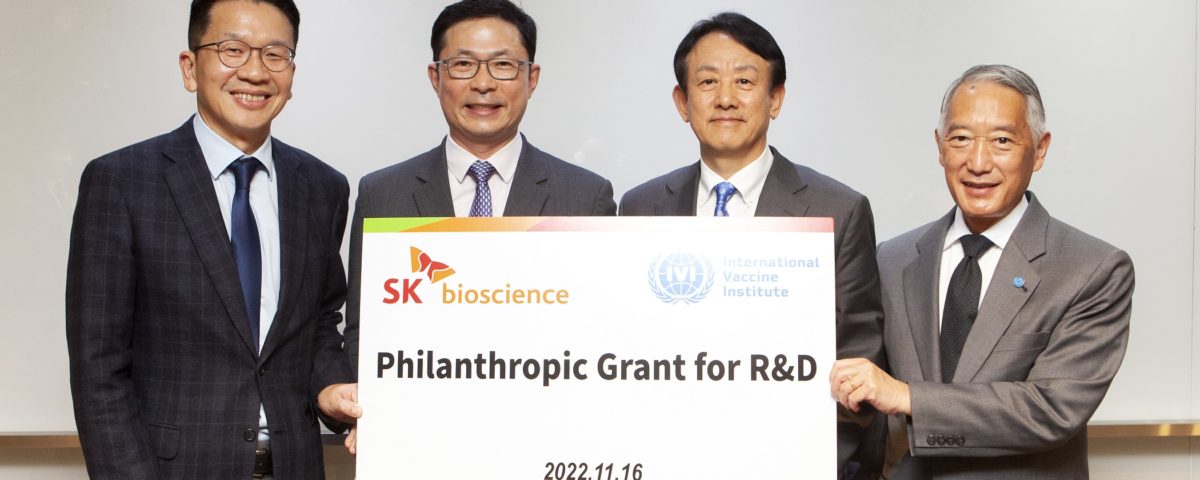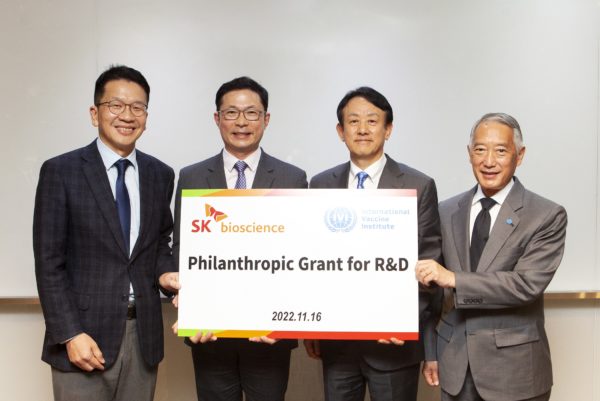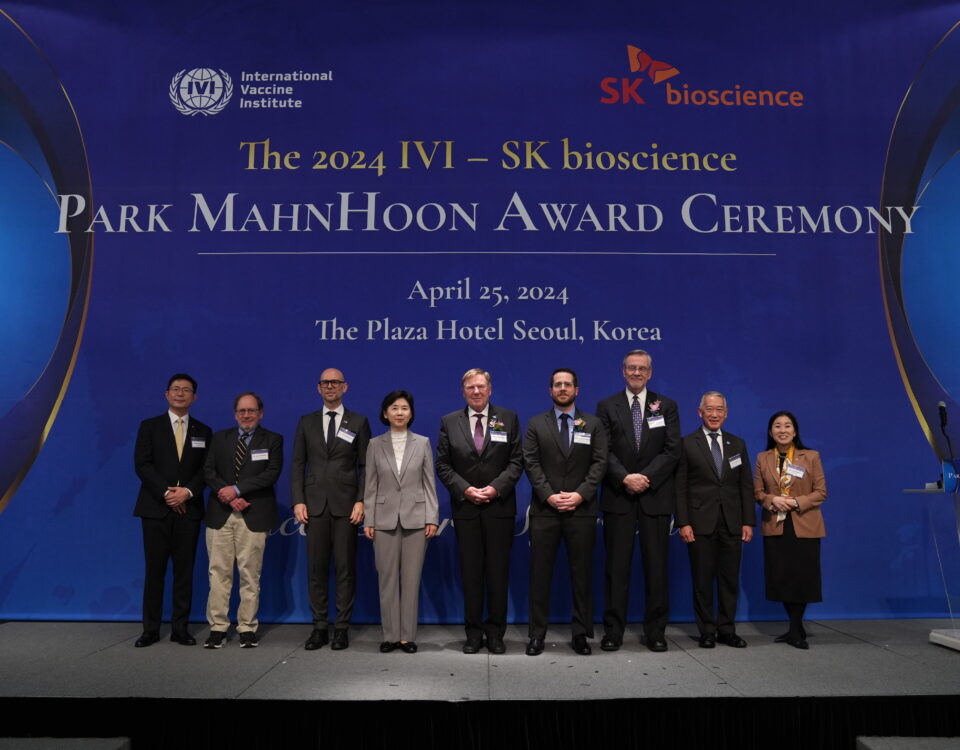- SK bioscience, IVI convene consultative meeting to discuss cooperation for next pandemic
- Company announces KRW3 billion donation to IVI to support advancement of global vaccine R&D
SK bioscience makes donation to IVI to support global R&D
SK bioscience makes donation to IVI to support global R&D

SK bioscience held a ceremony to make a philanthropic grant for R&D to the International Vaccine Institute at SK bioscience headquarters in Seongnam on November 16. (from left) SK Discovery Vice Chairman Chang-won Chey, and SK bioscience President Jae-yong Ahn, Dr. B.G. Rhee, Chairman of the Korea Support Committee for IVI’s Board of Trustees, and IVI Director General Dr. Jerome Kim.

November 17, 2022, SEOUL, Republic of Korea – SK bioscience, a leading vaccine manufacturer based in the Republic of Korea and a key partner of the International Vaccine Institute (IVI), is launching an initiative to support the advancement of vaccine research and development.
SK bioscience announced on November 16 that it had a consultative meeting with IVI to seek sustainable cooperation to respond to the next pandemic. The meeting, held at the SK bioscience headquarters in Seongnam, Gyeonggi Province on the day, was attended by IVI Director General Dr. Jerome Kim, Mr. George Bickerstaff, Chairperson of the IVI Board of Trustees and other Board members, Dr. B.G. Rhee, Chairman of the Korea Support Committee for IVI’s Board of Trustees, SK Discovery Vice Chairman Chang-won Chey, and SK bioscience President Jae-yong Ahn.
The meeting was followed by a donation ceremony. SK bioscience announced on the day that it would provide KRW 3 billion in donations to IVI to support vaccine R&D, and equipment and device purchases. The donation will be delivered to IVI through KSC in the form of a charitable donation.
SK bioscience and IVI have been working together for nearly 10 years to achieve the common goal of promoting global public health. Last year, SK bioscience successfully developed a typhoid vaccine, ‘SKYTyphoid (hereinafter ‘SKYTyphoid)’ which applied IVI’s conjugated vaccine production technology. From the early stage of research and development, the vaccine was supported with research funding from the Bill & Melinda Gates Foundation, and SK bioscience was in charge of R&D, production and licensing while IVI coordinated global clinical trials.
SKYTyphoid demonstrated its excellent immunogenicity and safety through global phase 3 clinical trials conducted in Nepal. Based on this result, the vaccine finally obtained an export license from the Korean Ministry of Food and Drug Safety in May of this year, and its global supply will start in earnest once WHO prequalification is achieved in the future.
Korea’s first COVID-19 vaccine, ‘SKYCovione (hereinafter as SKYCovione)’ is also a result of cooperation with IVI. SKYCovione, a synthetic antigen-based COVID-19 vaccine, underwent global clinical trials and sample analysis conducted in cooperation with IVI, which have demonstrated its excellent immunogenicity and safety.
The results of SKYCovione’s global phase 3 clinical trials suggested its excellent immunogenicity after basic vaccination compared to the comparator vaccine, AstraZeneca’s COVID-19 vaccine, and a follow-up study of Phase 1 and 2 trials showed a strong immune response to the omicron variant (BA.1). SKYCovione has now become an alternative option for people in Korea who are reluctant to get vaccinated due to safety concerns about vaccines adopting new technology. Currently SK bioscience is accelerating preparations including the WHO’s emergency use listing to launch the vaccine on the global market.
“With the two vaccines brought to market, the SK bioscience-IVI partnership has been one of the best examples of global public-private partnerships for accelerating the development of vaccines for global public health,” said Dr. Jerome Kim, Director General of IVI. “IVI is extremely grateful for SK bioscience’s leadership, generosity, and commitment to advancing IVI’s global vaccine R&D and we look forward to our continued robust partnership with SK bioscience.”
SK Discovery Vice Chairman Chang-won Chey, “The COVID-19 pandemic has illustrated that it is impossible for companies, institutions, or a government alone to cope with the next pandemic. Strengthening cooperation with IVI will be a cornerstone to protect the health and happiness of people through the advancement of vaccine R&D.”
###
About the International Vaccine Institute (IVI)
The International Vaccine Institute (IVI) is a non-profit international organization established in 1997 at the initiative of the United Nations Development Programme with a mission to discover, develop, and deliver safe, effective, and affordable vaccines for global health.
IVI’s current portfolio includes vaccines at all stages of pre-clinical and clinical development for infectious diseases that disproportionately affect low- and middle-income countries, such as cholera, typhoid, chikungunya, shigella, salmonella, schistosomiasis, hepatitis E, HPV, COVID-19, and more. IVI developed the world’s first low-cost oral cholera vaccine, pre-qualified by the World Health Organization (WHO), and developed a new-generation typhoid conjugate vaccine that is currently under assessment for WHO PQ.
IVI is headquartered in Seoul, Republic of Korea with a Europe Regional Office in Sweden and Collaborating Centers in Ghana, Ethiopia, and Madagascar. 39 countries and the WHO are members of IVI, and the governments of the Republic of Korea, Sweden, India, and Finland provide state funding. For more information, please visit https://www.ivi.int.
CONTACT
Aerie Em, Global Communications & Media Specialist
+82 2 881 1386 | aerie.em@ivi.int
Related posts
Awardees and dignitaries pose for a commemorative photo at the 2024 IVI – SK bioscience Park MahnHoon Award Ceremony at the Plaza Seoul Hotel on April 25, 2024. From left: Mr. Jae-Yong Ahn, President of SK bioscience; Dr. John Clemens, first Director General of IVI; Dr. Lars Hammarström, Head of the Office of Science & Innovation, Embassy of Sweden in Korea; Dr. Youngmee Jee, Commissioner of the Korea Disease Control and Prevention Agency; Prof. Jan Holmgren, Prof. Jason McLellan, Prof. Barney Graham, Dr. Jerome Kim, Director General of IVI; and Ms. Joy Sakurai, Deputy Chief of Mission, US Embassy, Seoul. Credit: IVI


